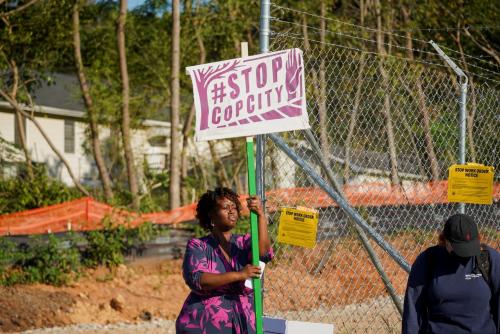The killing of George Floyd by a Minneapolis police officer has sparked a national reckoning over police violence and anti-Black racism in the United States. As protests continue, the country’s sprawling criminal justice and carceral system has once again been spotlighted as a powerful driver of racial inequality in the country.
Frustrated by the insufficiency of reform efforts undertaken since the police killing of Michael Brown in Ferguson, Mo. six years ago, the Black Lives Matter movement is now demanding cities reallocate public resources away from inflated police department budgets and approach public safety more holistically. And sure enough, nine of 13 Minneapolis city council members have already committed to disbanding the city’s police department, while other cities are entertaining substantial budget cuts as well.
However, as pressure builds for the dismantling of the country’s policing- and prison-industrial complex, advocates of defunding the carceral state must also contend with the role it has come to play in many smaller cities and rural quarters of the country: a de facto public jobs program.
In 2018, 2.8 million workers were directly employed in the “justice, public order, and safety” sector, encompassing the full scope of judicial, law enforcement, and correctional functions performed by federal, state, and local governments. This is over 1.5% of the total workforce; for comparison, less than 1% of Americans are employed in manufacturing cars and parts. In many rural communities, the purchasing power these jobs create is a significant source of demand for locally serving businesses, and many more workers are employed at businesses supplying and contracting with police departments, courthouses, and prisons.
Today, the nation’s criminal justice system employs roughly 1 million more workers than it did in 1990, while the country’s incarcerated population during that period has doubled to 2.2 million (down from a high of 2.3 million in 2008). There is a sharp racial disparity between these two groups: While two-thirds of workers in the criminal justice system are white, only 30% of federal and state prisoners are. Black Americans, the most disproportionately incarcerated of any group in the country, make up one-third of the federal and state prison population but account for less than 15% of workers in the criminal justice sector. Even at 15%, Black workers are still overrepresented in the justice and public order sector relative to their share of the national labor force—illustrating the complexities between mass incarceration and the jobs available in those communities.
Employment in the carceral state has become concentrated in some of the most depressed regional labor markets in the country. In 1990, no significant correlation existed between a region’s share of employment in the justice, public order, and safety sector and regional prime-age male labor force participation. By 2018, the regions where employment in the sector was most concentrated were also those where prime-age males were the least likely to be in the labor force. (Female labor force participation rose almost everywhere in this time, and even more so in places where nonparticipation was highest among both genders.)

Communities such as Pine Bluff, Ark., Pueblo, Colo., and Petersburg, Va., each home to a federal or state prison complex, are emblematic of this transformation (see Map 1). In each, the criminal justice system—already a relatively large source of local employment in 1990—came to account for an even greater share of jobs, while prime-age male labor force participation plummeted over 15 percentage points.

The collapse in prime-age male labor force participation in rural and small metro areas has been driven by white, Black, and Native American men. These are also the same groups who are overrepresented among workers in the justice and public order sector relative to their share of the labor force. Black Americans living in nonmetropolitan regions saw a nearly 10 percentage point drop in prime-age male labor force participation between 1990 and 2018, while simultaneously becoming one of the most overrepresented groups in justice and public order jobs, along with Black workers living in metropolitan areas (see Table 1).

Rural regions’ dependence on employment and income from the criminal justice system in no way diminishes the urgency of bringing an end to mass incarceration. But we must be clear-eyed in recognizing that decarceration and budget cuts to police departments and prisons—particularly at the state and federal level—will have major implications for what are already some of the weakest labor markets in the country, many of them disproportionately Black.
That said, the model of incarceration-as-economic-development has utterly failed to prevent widespread joblessness in these places. The challenge of economic development in rural areas post-mass incarceration is the same challenge shared by most places in the country: too few jobs at too low wages.
A full employment agenda based on large, targeted public investments in any number of national priorities—new affordable housing, improved mass transit, expanded rural medical and elder care facilities, renewable energy sources, universal child care, job training and apprenticeships for young workers—can serve as a unifying ambition for the American working class, no matter their race or where they reside.
In formulating this full employment strategy, preferential consideration should be given to the those who have been incarcerated. These workers, disproportionately people of color, face considerable barriers and discrimination in the labor market. Moreover, this effort should not be undertaken as a “race-neutral” substitute for reparations to Black Americans, whose exploitation and oppression long predate the mass incarceration era.
At a time when many states are experiencing Depression-level unemployment resulting from the COVID-19 pandemic, the time is ripe to knit demands for transformative change in the American criminal justice system into a broader vision of an economy that is inclusive and creates wealth and opportunity for everyone.
Until we make full employment in all parts of the country a national mission, many rural communities will continue to have a strong material interest in the preservation of a cruel and inhumane system that has provided them a meager lifeline by criminalizing the long-standing poverty of Black and Latino or Hispanic Americans everywhere. Mass incarceration must end, and it must be replaced by deliberate policy fit for better purposes.
The Brookings Institution is committed to quality, independence, and impact.
We are supported by a diverse array of funders. In line with our values and policies, each Brookings publication represents the sole views of its author(s).



Commentary
In too many American communities, mass incarceration has become a jobs program
June 18, 2020